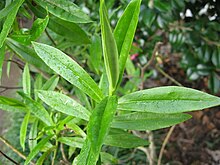
Veronica sect. Hebe is a group of plants within the genus Veronica, native to New Zealand, Rapa in French Polynesia, the Falkland Islands and South America. It was formerly treated as the separate genus Hebe. It includes about 90 species. Almost all species occur in New Zealand, apart from Veronica rapensis and Veronica salicifolia, found in South America. It is named after the Greek goddess of youth, Hebe. Informally, species in the section may be called shrubby veronicas or hebes.
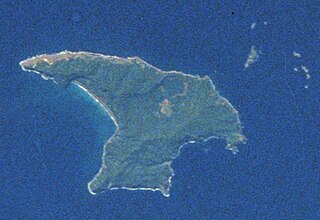
Raoul Island is the largest and northernmost of the main Kermadec Islands, 900 km (560 mi) south south-west of 'Ata Island of Tonga and 1,100 km (680 mi) north north-east of New Zealand's North Island. It has been the source of vigorous volcanic activity during the past several thousand years that was dominated by dacitic explosive eruptions.

The Kermadec Islands are a subtropical island arc in the South Pacific Ocean 800–1,000 km (500–620 mi) northeast of New Zealand's North Island, and a similar distance southwest of Tonga. The islands are part of New Zealand. They are 33.6 km2 (13.0 sq mi) in total area and uninhabited, except for the permanently staffed Raoul Island Station, the northernmost outpost of New Zealand.

Little Barrier Island, or Hauturu in Māori, lies off the northeastern coast of New Zealand's North Island. Located 80 kilometres (50 mi) to the north of Auckland, the island is separated from the mainland to the west by Jellicoe Channel, and from the larger Great Barrier Island to the east by Cradock Channel. The two aptly named islands shelter the Hauraki Gulf from many of the storms of the Pacific Ocean.

Veronica is the largest genus in the flowering plant family Plantaginaceae, with about 500 species. It was formerly classified in the family Scrophulariaceae. Common names include speedwell, bird's eye, and gypsyweed.
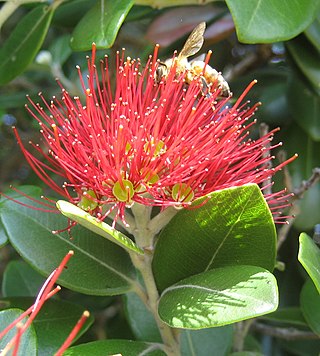
Metrosideros kermadecensis, with common names Kermadec pōhutukawa and New Zealand Christmas bush is an evergreen tree of the myrtle family which is endemic to the volcanic Kermadec Islands about 900 km north-east of New Zealand. The tree produces a brilliant display of red flowers, made up of a mass of stamens and is the dominant forest tree on Raoul Island, growing to 15 m or more. The trunk is up to 1 m or more in diameter. It is very similar to, and often confused with, the pōhutukawa of mainland New Zealand, differing mainly by having smaller, more oval leaves, and by flowering throughout the year. It also resembles the ʻōhiʻa lehua of Hawaii.

Veronica speciosa, synonym Hebe speciosa, is a species of flowering plant in the family Plantaginaceae, known by the common names New Zealand hebe, showy hebe, showy-speedwell, and the Māori names titirangi and napuka. Like most hebes, it is native to New Zealand but it can be found in other parts of the world where it is grown as an ornamental for its showy flowers.

Veronica hulkeana, synonym Hebe hulkeana, the New Zealand lilac, is a species of plant in the Plantaginaceae. Its pale mauve flowers are on long sprays, which develop from the tips of the branches. The dainty flowers, which occur in profusion, last from October until December. The foliage is dark green and shiny. The leaves are elliptic to obtuse in shape and are 7–10 cm long and 2–3 cm wide. This cold-hardy plant is easy to grow, providing it has well drained, light soil and an open, sunny position. Its natural habitat is in dry rocky places in the northern part of the South Island up to an altitude of 900 m.

Veronica stricta, synonym Hebe stricta, commonly called koromiko, is a flowering plant in the family Plantaginaceae, which is endemic to New Zealand.

Veronica albicans, synonym Hebe albicans, is a species of flowering plant in the family Plantaginaceae, native to New Zealand.
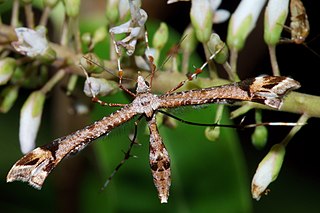
Amblyptilia falcatalis, the common Hebe plume moth, is a species of moth of the family Pterophoridae. This species was first described by Francis Walker and is endemic to New Zealand. This species can be found in both the North and South Islands. The larval host plants are in the Veronica genus and include Veronica stricta,Veronica salicifolia,Veronica elliptica, Veronica macrocarpa and Veronica speciosa. This moth likely has two broods a year and adults have been observed all year round.

Veronica odora, known as the boxwood hebe, mountain-box, Hebe odora or Hebe buxifolia, is a plant in the family Plantaginaceae, and it is native to New Zealand. Veronica odora was discovered on the Auckland Islands by J.D Hooker in 1840. A certain amount of confusion later arose following its collection on mainland New Zealand by Ernst Dieffenbach and its naming as Veronica buxifolia by George Bentham. Even overseas, Veronica odora is still not infrequently known as Veronica buxifolia.

Veronica pimeleoides, synonym Hebe pimeleoides, is a flowering plant of the family Plantaginaceae. It is endemic to the dry mountains of Marlborough and Canterbury, in South Island of New Zealand. It is a low-growing, evergreen shrub, reaching 60 cm in height, with grey-green, spear-shaped leaves that are 7–10 mm long. Flowers are pale lilac.

Veronica salicifolia, synonym Hebe salicifolia, the koromiko, or willow-leaf hebe, is a flowering plant in the family Plantaginaceae, which is found throughout the South Island of New Zealand and in Chile. It is a large, evergreen shrub, reaching 2 m in height, with light-green, spear-shaped leaves that are up to 12 cm long, and white or pale lilac flowers.

Veronica tetragona, synonym Hebe tetragona, is a subalpine plant of the family Plantaginaceae, which is endemic to New Zealand.

Veronica pauciramosa, synonym Hebe pauciramosa, is a species of plant in the family Plantaginaceae, endemic to the South Island of New Zealand, where it grows in mountains. It is an upright, evergreen shrub about 16 in (40 cm) tall, with green, spear-shaped leaves 0.2 in (6 mm) long, and white flowers.

Veronica strictissima, the Banks Peninsula hebe, is a species of flowering plant in the family Plantaginaceae. It is only found on Banks Peninsula in New Zealand.
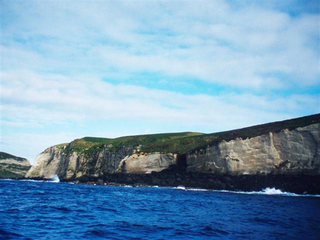
Macauley Island is a volcanic island in New Zealand's Kermadec Islands, approximately halfway between New Zealand's North Island and Tonga in the southwest Pacific Ocean. It is part of a larger submarine volcano that features a 10.5 by 7 kilometres wide underwater caldera northwest of Macauley Island. Two islets, Haszard Island and Newcome Rock, lie east offshore of Macauley Island. The island is mostly surrounded by high cliffs that make accessing it difficult; the inland parts are mostly gently sloping terrain covered with ferns and grasses.

Veronica bishopiana, the Waitākere rock koromiko, is a flowering plant belonging to the family Plantaginaceae. It is native to West Auckland in New Zealand, and was first described by Donald Petrie in 1926.

Veronica obtusata, the northern hebe, is a flowering plant belonging to the family Plantaginaceae. It is native to northern New Zealand, and was first described by Thomas Cheeseman in 1916.
